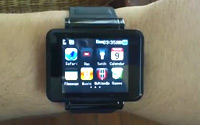
Marketers need to start thinking about how to optimize content and related ads that appear in wearable tech devices.
An Apple
application patent claim surfaced Thursday describing a flexible, wearable video device designed like a wristband.
Analysts believe it's too early to determine
how marketers will need to optimize content, but marketers should consider the impact from Google Now or Apple Siri -- technology aimed at serving information even before making a request or
search.
advertisement
advertisement
It might provide insights on the future of online advertising where content plays a bigger role.
Wearable technology describes products worn on an individual's body for
extended periods of time, enhancing the user experience, such as Google Glasses, Apple's iWatch, cocktail dresses that light up when a cell phone rings and sports bras that monitor heart rates.
The market fits into four categories: fitness and wellness, health care and medical, industrial and military, and infotainment used to receive and transmit real-time information for entertainment,
per IHS Research. Some 14 million wearable technology devices shipped in 2011, according to the research firm, but units shipped could rise to 92.5 million by 2016.
It does depend on adoption
rates. Limiting product availability and deficient overall experience could stifle initial growth to 39.2 million by 2016, according to IHS. Even with these challenges, shipped devices could grow
nearly threefold between 2011 and 2016. Improved functions and varying functions spurring quick adoption could push growth 12-fold to 171 million devices shipped in 2016.
In the high-end
forecast, infotainment is projected to account for the largest revenue share of 38% by 2016, driven by the uptake of smart watches and smart glasses, according to IHS. The United States is the leading
region for wearable devices; IHS doesn't expect this to change any time soon.